There was an excellent turnout for this evening where we welcomed Gregory Moreton to give us a demonstration. After a brief introduction Gregory started to demonstrate making of a lamp stand in 3 pieces out of Banksia Nut / Seed Pod and recycled Jarra fence post.
The first nut was mounted between centres with the first process was to remove the soft furry outer coating which was turned away using a roughing spindle gouge. 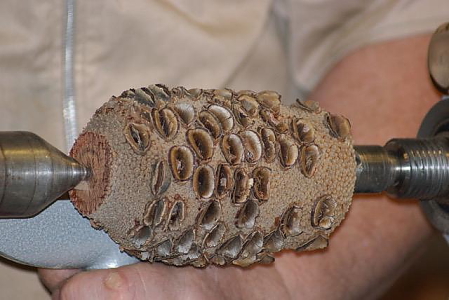
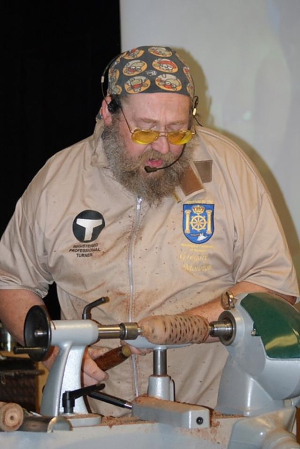 One thing to bear in mind is that with Bansia Nuts the “grain” does not run as a normal log it is across the nut. Effectively it is faceplate orientation and should be turned and processed as you would a bowl blank. The next task was to drill through the centre of the nut using an auger.
One thing to bear in mind is that with Bansia Nuts the “grain” does not run as a normal log it is across the nut. Effectively it is faceplate orientation and should be turned and processed as you would a bowl blank. The next task was to drill through the centre of the nut using an auger.  Tip here was not to drill more than one inch at a time and withdraw the bit to clear the swarf. Only drill half way through then reverse and repeat for the other end. A 1 inch hole can then be counter bored at one end to accept a mating tenon. The nut can then be remounted between centres using the hole and the outside trued up. The base can then be shaped to what you want with the top edge shaped so that the joint with the next nut can be disguised.
Tip here was not to drill more than one inch at a time and withdraw the bit to clear the swarf. Only drill half way through then reverse and repeat for the other end. A 1 inch hole can then be counter bored at one end to accept a mating tenon. The nut can then be remounted between centres using the hole and the outside trued up. The base can then be shaped to what you want with the top edge shaped so that the joint with the next nut can be disguised.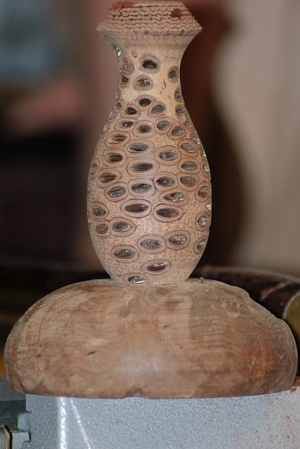 One thing you will need to do before finishing is to remove debris, seeds and sometimes critters from the holes. The little critter should be killed by the sterilising of the nut but if you get them from a non reputable source they could still be alive. As these nuts come from Australia they could be nasty. However, the risks are low. The fibres in the nut mean that sanding should be done first in forward motion and then in reverse to give the best finish.
One thing you will need to do before finishing is to remove debris, seeds and sometimes critters from the holes. The little critter should be killed by the sterilising of the nut but if you get them from a non reputable source they could still be alive. As these nuts come from Australia they could be nasty. However, the risks are low. The fibres in the nut mean that sanding should be done first in forward motion and then in reverse to give the best finish.
Finish with sanding sealer then wax. The final process is to use a brush on the nut to remove the excess wax from the seed holes. Create a 1 inch tenon at the top of the nut and part off.
The second nut is treated in exactly the same way except that the top in this instance is opened out slightly to accept a brass light insert.
The base was made from a piece of recycled Jarra fence post turned in faceplate orientation on a screw chuck with a hole in the top to accept the tenon on the nut. 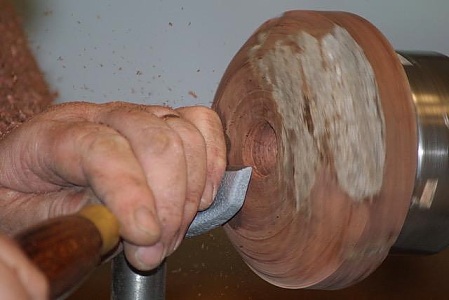 A hole is drilled through the side of the base into the centre hole so that a flex can be inserted. All of the parts should be finished. The whole thing can then be glued and assembled. Gregory showed us a table lamp that he had completed previously.
A hole is drilled through the side of the base into the centre hole so that a flex can be inserted. All of the parts should be finished. The whole thing can then be glued and assembled. Gregory showed us a table lamp that he had completed previously. It really did look interesting and different from the usual wooden lamps.
It really did look interesting and different from the usual wooden lamps.
After a cup of tea Gregory showed how he makes a rustic pen pot out of an old fence post, however, instead of boring into end grain the blank is mounted in cross grain orientation and he bores a 2 inch hole onto this. The outside is then turned to the shape you want leaving some of the flat surfaces for contrast and texture. Again this is faceplate work so a bowl gouge is used unless you need to make a sharp V groove when a spindle gouge or skew can be used. However, you need to make a steep cut. The round areas can be sanded but the flat areas need the natural surface texture to be cleaned up. This was done using a draper nylon brush in a Jacob’s chuck or a wire brush by hand.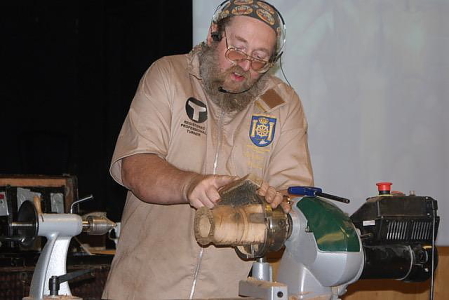
 The chucking marks are cut off as a slice on the band saw. The piece was waxed but the textured areas were brushed using a polishing brush in the Jacob’s chuck.
The chucking marks are cut off as a slice on the band saw. The piece was waxed but the textured areas were brushed using a polishing brush in the Jacob’s chuck.
The last item was a Banksia Nut sphere which was mounted between centres then roughed and prepared the same as previously. The blank was marked so that the diameter and the working length were the same. The blank was roughly turned to the sphere shape then removed from the centres. The 2 spigots were cut down with a saw and the blank remounted between 2 cupped centres. When you spin this you see a solid section with a ghost around it. The solid is the true sphere so the trick now is to remove the ghost image. Light cuts, a bit of patience and moving the blank around gets you to the finished sphere. Sand and finish and there you have it.
The whole evening proved to be interesting, informative and entertaining.
August Competition.
The competition table was full tonight with many excellent pieces.
3rd place was a platter with laburnum inlays made by Mick Denton.
2nd place was a clock by Roger Gilbert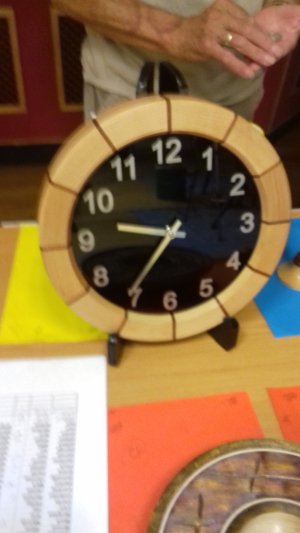
1st place was a lidded bowl and stand by Ken Garratt
